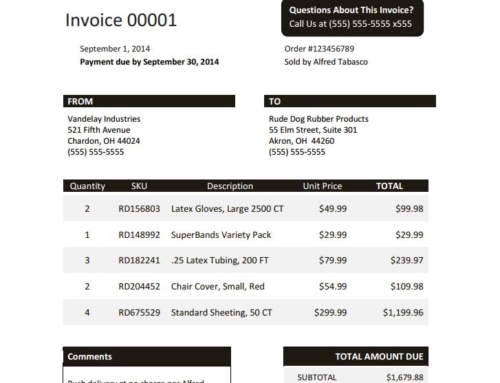Monitoring your accounts receivable performance is the first step in improving the way you manage it; after all, “If you don’t know where you are going, you will probably end up somewhere else.” (Laurence J. Peter ). Below we’ve compiled and explained, in plain English, some of the most common ways to monitor accounts receivable. These are the important A/R metrics you should consider when measuring accounts receivable performance and how to interpret them to better gauge the health of your collections and overall cash flow.
DAYS SALES OUTSTANDING (DSO)
This is a commonly used but often times, misused, measurement of A/R management performance. Don’t get me wrong, this is an important A/R metric, but you must make sure you are using it and interpreting it correctly. DSO is used to calculate how quickly you are able to collect the money owed to you after the sale has been completed; the average collection period.
DSO= (Accounts receivable / total credit sales) x number of days in period.
Interpreting this metric correctly is critical. First it is important to note that each industry has a different average DSO, so you will want to do some research to see how yours measures up to your peers. Typically you want DSO to exceed your terms by no more than half. So if you operate on payment terms of 30 days and you’re seeing payment in 45 days, you’re doing pretty well.
DSO V. BEST POSSIBLE DSO: The goal is to get your DSO to be as close as you can to Best Possible DSO which will indicate you are collecting on invoices as quickly as possible. It is nearly impossible to get these numbers to match up perfectly, so if you can get within 3-5 days you are doing great!
Best Possible Days Sales Outstanding= (Current receivables x number of days in period) / credit sales for period
It is important to remember that DSO should never be the end-all-be-all of your investigation into accounts receivable performance. You will also need to look at the other accounts receivable performance metrics mentioned below to paint a complete picture. Also remember:
- DSO fluctuates with revenue and other short-term changes.
- Because of its tendency to fluctuate, analyzing DSO on a period less than a year can be misleading.
- DSO takes into account only credit sales, not cash sales.
- Always look at your DSO with context with your company’s terms.
AVERAGE DAYS DELINQUENT (ADD)
ADD tells you how efficient and effective your processes are in your ability to collect receivables on time.
ADD= Days Sales Outstanding – Best Possible Days Sales Outstanding
You will want to look at your ADD and DSO together- I suggest plotting them on a line graph for a better visual of what is happening in their relationship, but looking at the number side-by-side is also acceptable.
If ADD and DSO traveling up/down together: This means that you can assume your processes are either helping (upward trend) or hurting (downward trend) your ability to collect receivables. If you see that both these numbers are dropping, you will want to look into ways to improve your processes to become more effective in collections.
If DSO & ADD are moving in different directions: This means that there is something else going on and you should absolutely take a closer look. For example, if DSO is rising while ADD is falling, the improvement in DSO was probably not driven by improved collection efficiencies; rather it may have been due to shorter A/R cycles or a change in credit terms.
COLLECTION EFFECTIVENESS INDEX (CEI)
Put most simply, the CEI compares how much money was owed to the company and how much of that money was actually collected in the given time period, usually one year. The resulting percentage allows the company to gauge how strong their current collections policies and procedures are and whether or not changes need to be made.
CEI= (Beginning receivables + Monthly credit sales – Ending total receivables) / (Beginning receivables + Monthly credit sales – Ending current receivables) x 100
The closer the resulting percent is to 100% the stronger your collections processes and policies are. A low or dropping percentage means it is time to re-evaluate your policies on selling on credit and the processes your collectors are following. If you find it is time to reevaluate your policies and procedures, download this guide to developing a credit and collections policy and procedures manual that will get your CEI percentages to where they need to be.
CEI VS. DSO: On the surface DSO and CEI sound very similar, but there is a very important difference to note. DSO provides insight into collections during one point in time, usually periods of less than a year. DSO also is a measurement of time, how long it takes for you to collect on an invoice once it is sent.
CEI measures the effectiveness of your accounts receivable management and collections performance over a longer period of time, generally a year although the formula can be manipulated for smaller segments of time. Additionally CEI differs from DSO because it is not a measurement of time, it measure the overall quality of your collections processes.
Generally DSO and CEI should move in opposite directions, which makes sense if you think about what each represents. There a few exceptions to this rule so don’t panic if yours are not behaving as such.
ACCOUNTS RECEIVABLE TURNOVER RATIO (ART)
The ART measures how many times your company turns accounts receivable into cash during a period; usually over one year.
ART= Net credit sales/average accounts receivable
A higher ratio means you are turning A/R into cash more frequently; if, for example, your ration is 2, you collect average A/R twice a year, every 6 months. The more frequently you are collecting, the higher your cash flow and liquidity.
There are a number of different things you can do and small changes you can make to improve your metrics and overall accounts receivable performance.
- Developing or re-evaluating your credit policy.
- Standardizing your credit collections communications with templates.
- Making sure you have the right number of employees focused on the task.
What does accounts receivable software really cost?
Find out in our whitepaper!




